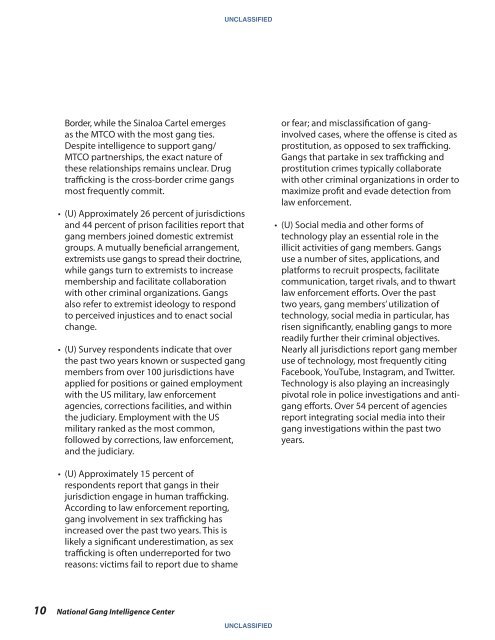UNCLASSIFIED UNCLASSIFIED
h39y582
h39y582
Create successful ePaper yourself
Turn your PDF publications into a flip-book with our unique Google optimized e-Paper software.
<strong>UNCLASSIFIED</strong><br />
Border, while the Sinaloa Cartel emerges<br />
as the MTCO with the most gang ties.<br />
Despite intelligence to support gang/<br />
MTCO partnerships, the exact nature of<br />
these relationships remains unclear. Drug<br />
trafficking is the cross-border crime gangs<br />
most frequently commit.<br />
• (U) Approximately 26 percent of jurisdictions<br />
and 44 percent of prison facilities report that<br />
gang members joined domestic extremist<br />
groups. A mutually beneficial arrangement,<br />
extremists use gangs to spread their doctrine,<br />
while gangs turn to extremists to increase<br />
membership and facilitate collaboration<br />
with other criminal organizations. Gangs<br />
also refer to extremist ideology to respond<br />
to perceived injustices and to enact social<br />
change.<br />
• (U) Survey respondents indicate that over<br />
the past two years known or suspected gang<br />
members from over 100 jurisdictions have<br />
applied for positions or gained employment<br />
with the US military, law enforcement<br />
agencies, corrections facilities, and within<br />
the judiciary. Employment with the US<br />
military ranked as the most common,<br />
followed by corrections, law enforcement,<br />
and the judiciary.<br />
or fear; and misclassification of ganginvolved<br />
cases, where the offense is cited as<br />
prostitution, as opposed to sex trafficking.<br />
Gangs that partake in sex trafficking and<br />
prostitution crimes typically collaborate<br />
with other criminal organizations in order to<br />
maximize profit and evade detection from<br />
law enforcement.<br />
• (U) Social media and other forms of<br />
technology play an essential role in the<br />
illicit activities of gang members. Gangs<br />
use a number of sites, applications, and<br />
platforms to recruit prospects, facilitate<br />
communication, target rivals, and to thwart<br />
law enforcement efforts. Over the past<br />
two years, gang members’ utilization of<br />
technology, social media in particular, has<br />
risen significantly, enabling gangs to more<br />
readily further their criminal objectives.<br />
Nearly all jurisdictions report gang member<br />
use of technology, most frequently citing<br />
Facebook, YouTube, Instagram, and Twitter.<br />
Technology is also playing an increasingly<br />
pivotal role in police investigations and antigang<br />
efforts. Over 54 percent of agencies<br />
report integrating social media into their<br />
gang investigations within the past two<br />
years.<br />
• (U) Approximately 15 percent of<br />
respondents report that gangs in their<br />
jurisdiction engage in human trafficking.<br />
According to law enforcement reporting,<br />
gang involvement in sex trafficking has<br />
increased over the past two years. This is<br />
likely a significant underestimation, as sex<br />
trafficking is often underreported for two<br />
reasons: victims fail to report due to shame<br />
10<br />
National Gang Intelligence Center<br />
<strong>UNCLASSIFIED</strong>


